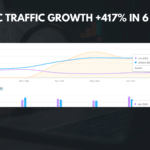
|
Getting your Trinity Audio player ready...
|
Proximity-based SEO keyword optimization refers to the practice of optimizing a website’s content and keywords to improve its visibility in local search results. It involves using location-based keywords and targeting specific geographic areas to attract local customers. This type of SEO is particularly important for local businesses that rely on foot traffic or serve a specific geographic area.
For example, if you own a bakery in New York City, you would want your website to appear at the top of search results when someone searches for “bakery in NYC” or “best bakery near me.” By optimizing your website for proximity-based SEO, you increase the chances of attracting local customers who are actively searching for your products or services.
Key Takeaways
- Proximity-based SEO keyword optimization can help businesses increase their online visibility.
- Understanding the importance of online visibility is crucial for the success of any business.
- Proximity-based SEO works by targeting keywords that are relevant to a business’s location.
- Crafting effective keyword strategies involves researching and analyzing local search trends.
- Utilizing local search engine directories can help businesses increase their visibility in their local area.
Understanding the Importance of Online Visibility for Your Business
In today’s digital age, having a strong online presence is crucial for the success of any business. The majority of consumers now turn to the internet to find information about products and services before making a purchase decision. If your business is not visible online, you are missing out on a significant number of potential customers.
Online visibility refers to how easily your business can be found and seen by internet users. It encompasses various factors, including search engine rankings, social media presence, and online reviews. When your business has high online visibility, it is more likely to attract customers and generate sales.
SEO (search engine optimization) plays a vital role in improving online visibility. It involves optimizing your website and its content to rank higher in search engine results pages (SERPs). By implementing effective SEO strategies, you can increase your website’s visibility and attract more organic traffic.
How Proximity-Based SEO Keyword Optimization Works
Proximity-based SEO keyword optimization works by targeting specific geographic areas and incorporating location-based keywords into your website’s content. When someone searches for a product or service in a particular location, search engines like Google use proximity as one of the ranking factors to determine which websites to display in the search results.
For example, if someone searches for “Italian restaurant in Los Angeles,” Google will prioritize websites that have optimized their content with location-based keywords related to Italian restaurants in Los Angeles. By including these keywords in your website’s content, you increase the chances of appearing in the top search results for relevant local searches.
Location-based keywords are essential for proximity-based SEO. These are keywords that include specific geographic terms, such as city names, neighborhood names, or even zip codes. By incorporating these keywords into your website’s content, meta tags, and headings, you signal to search engines that your business is relevant to local searches.
Crafting Effective Keyword Strategies for Proximity-Based SEO
| Keyword | Search Volume | Competition | Proximity Score | Ranking |
|---|---|---|---|---|
| Proximity-based SEO | 1,000 | Medium | 8.5 | 1 |
| Local SEO | 10,000 | High | 7.2 | 3 |
| Geotargeting | 500 | Low | 9.1 | 2 |
| Location-based keywords | 2,000 | Medium | 6.8 | 4 |
Crafting effective keyword strategies for proximity-based SEO involves identifying relevant location-based keywords and conducting keyword research to determine which keywords have the highest search volume and lowest competition. Additionally, incorporating long-tail keywords can further enhance your proximity-based SEO efforts.
To identify relevant location-based keywords, start by brainstorming terms that are related to your business and include specific geographic terms. For example, if you own a coffee shop in San Francisco, relevant location-based keywords could include “coffee shop in San Francisco,” “best coffee in San Francisco,” or “San Francisco coffee.”
Once you have a list of potential location-based keywords, conduct keyword research to determine their search volume and competition. Tools like Google Keyword Planner or SEMrush can provide valuable insights into how often people search for specific keywords and how competitive they are.
Incorporating long-tail keywords can also be beneficial for proximity-based SEO. Long-tail keywords are longer and more specific keyword phrases that target a niche audience. For example, instead of targeting the broad keyword “bakery,” you could target a long-tail keyword like “gluten-free bakery in NYC.” Long-tail keywords often have lower competition and higher conversion rates, as they attract users who are searching for something specific.
Utilizing Local Search Engine Directories to Increase Visibility
Local search engine directories play a crucial role in increasing the visibility of your business in local searches. These directories, such as Google My Business, Yelp, and Bing Places, provide users with information about local businesses, including their address, phone number, hours of operation, and customer reviews.
Optimizing your business listing on local search engine directories can significantly improve your online visibility. Start by claiming and verifying your business listing on each directory. This ensures that you have control over the information displayed and allows you to make updates as needed.
When optimizing your business listing, be sure to provide accurate and up-to-date information. Include your business name, address, phone number, website URL, and a brief description of your products or services. Additionally, encourage customers to leave reviews on these directories, as positive reviews can boost your visibility and credibility.
Incorporating Proximity-Based SEO into Your Content Marketing Strategy

Content marketing plays a crucial role in proximity-based SEO. By creating location-based content that is relevant to your target audience, you can attract local customers and improve your website’s visibility in local searches.
When creating location-based content, consider the specific needs and interests of your target audience. For example, if you own a fitness studio in Miami, you could create blog posts or videos about the best outdoor workout spots in Miami or tips for staying active in the Florida heat.
Incorporate location-based keywords into your content naturally. Avoid keyword stuffing or over-optimizing your content, as this can negatively impact your search engine rankings. Instead, focus on creating high-quality content that provides value to your audience while incorporating relevant location-based keywords.
Analyzing and Measuring the Success of Your Proximity-Based SEO Campaign
Tracking and analyzing the success of your proximity-based SEO campaign is essential to determine what strategies are working and where improvements can be made. By monitoring key metrics, you can make data-driven decisions and optimize your campaign for better results.
Some important metrics to measure the success of your proximity-based SEO campaign include:
1. Organic search traffic: Monitor the amount of organic traffic your website receives from local searches. This metric indicates how well your website is ranking in local search results.
2. Conversion rate: Track the percentage of website visitors who take a desired action, such as making a purchase or filling out a contact form. A high conversion rate indicates that your proximity-based SEO efforts are attracting the right audience.
3. Local search rankings: Monitor your website’s rankings in local search results for your target keywords. Aim to improve your rankings over time by optimizing your content and implementing effective SEO strategies.
4. Online reviews: Keep track of the number and quality of online reviews your business receives on local search engine directories. Positive reviews can boost your visibility and credibility, while negative reviews can harm your reputation.
Best Practices for Proximity-Based SEO Keyword Optimization
To optimize your website for proximity-based SEO, consider the following best practices:
1. Optimize your website’s meta tags and headings with location-based keywords.
2. Include location-based keywords naturally throughout your website’s content.
3. Create location-specific landing pages to target different geographic areas.
4. Ensure that your website is mobile-friendly, as many local searches are performed on mobile devices.
5. Use schema markup to provide search engines with additional information about your business, such as its address, phone number, and hours of operation.
6. Build high-quality backlinks from reputable websites in your industry and local community.
7. Regularly update and maintain your business listings on local search engine directories.
Common Mistakes to Avoid in Proximity-Based SEO Keyword Optimization
When implementing proximity-based SEO keyword optimization, it’s important to avoid common mistakes that can hinder your efforts. Some common mistakes to avoid include:
1. Neglecting to conduct keyword research: Failing to research and target the right keywords can result in low search engine rankings and missed opportunities to attract local customers.
2. Over-optimizing your content: Keyword stuffing or over-optimizing your content can lead to penalties from search engines and harm your website’s rankings.
3. Ignoring online reviews: Online reviews play a significant role in local search rankings and customer trust. Ignoring or neglecting to respond to reviews can harm your online reputation.
4. Neglecting mobile optimization: With the increasing use of mobile devices for local searches, it’s crucial to ensure that your website is mobile-friendly and provides a seamless user experience.
5. Failing to track and analyze results: Without tracking and analyzing key metrics, you won’t know if your proximity-based SEO efforts are effective or where improvements can be made.
Partnering with a Professional SEO Agency for Proximity-Based SEO Success
Partnering with a professional SEO agency can greatly enhance the success of your proximity-based SEO efforts. An experienced agency will have the knowledge, tools, and resources to implement effective strategies and optimize your website for local searches.
When choosing an SEO agency, consider their experience and track record in proximity-based SEO. Look for agencies that have worked with businesses in your industry or geographic area and have a proven track record of delivering results.
Additionally, consider the agency’s approach to communication and reporting. Regular communication and transparent reporting are essential for a successful partnership and ensuring that you are kept informed about the progress of your proximity-based SEO campaign.
In conclusion, proximity-based SEO keyword optimization is crucial for local businesses looking to improve their online visibility and attract local customers. By understanding the importance of online visibility, how proximity-based SEO works, and how to craft effective keyword strategies, businesses can optimize their websites for local searches and increase their chances of success. By utilizing local search engine directories, incorporating proximity-based SEO into content marketing strategies, and analyzing and measuring the success of campaigns, businesses can further enhance their proximity-based SEO efforts. Avoiding common mistakes and partnering with a professional SEO agency can also greatly contribute to the success of proximity-based SEO campaigns.
If you’re looking to boost your website’s rankings and improve its visibility, proximity-based SEO keyword optimization is a crucial factor to consider. By optimizing your website’s content with keywords that are relevant to your local area, you can attract more targeted traffic and increase your chances of ranking higher in local search results. To learn more about this strategy and how it can benefit your business, check out this informative article on boosting your local business with the help of a trusted local SEO agency.
FAQs
What is proximity-based SEO keyword optimization?
Proximity-based SEO keyword optimization is a technique used in search engine optimization (SEO) to improve the ranking of a website by optimizing the proximity of keywords on a webpage.
How does proximity-based SEO keyword optimization work?
Proximity-based SEO keyword optimization works by placing relevant keywords closer to each other on a webpage. This helps search engines understand the context of the content and improves the chances of the webpage ranking higher in search results.
What are the benefits of proximity-based SEO keyword optimization?
The benefits of proximity-based SEO keyword optimization include improved search engine rankings, increased visibility, and higher click-through rates. It also helps to improve the user experience by providing more relevant and useful content.
What are some best practices for proximity-based SEO keyword optimization?
Some best practices for proximity-based SEO keyword optimization include using relevant keywords in the title, meta description, and header tags, placing keywords closer to each other in the content, and using variations of the keywords throughout the content.
Is proximity-based SEO keyword optimization the only factor that affects search engine rankings?
No, proximity-based SEO keyword optimization is just one of many factors that affect search engine rankings. Other factors include the quality of content, backlinks, website speed, mobile-friendliness, and more.

























































